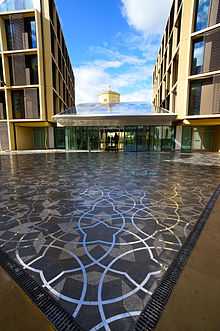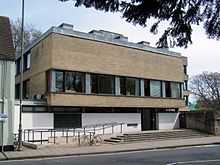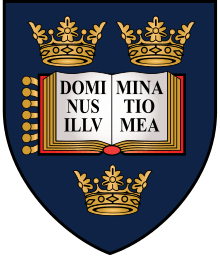Mathematical Institute, University of Oxford

The Mathematical Institute is the mathematics department at the University of Oxford, England. It forms one of the ten departments of the Mathematical, Physical and Life Sciences Divisional Board in the University.
Overview
Oxford Mathematics includes both pure and applied mathematics (statistics is a separate department) and is one of the largest and most respected mathematics departments in the UK with about 90 faculty.[1] Its research covers a range of fields from, for example, Algebra and Number Theory to the applications of mathematics to industry, climate, and the brain. It has over 850 undergraduates, over 200 postgraduates and around 150 MSc students.
As of Michaelmas term 2013 Oxford Mathematics has been unified and is now housed in the striking, purpose built Andrew Wiles Building on the Radcliffe Observatory Quarter in North Oxford, near the original Radcliffe Observatory. Sir Andrew Wiles, a Royal Society Research Professor at the University of Oxford, is best known for proving Fermat's Last Theorem.
History

Prior to this the Institute was located in multiple buildings. The main one was built in 1966 and was located at the northern end of St Giles' near the junction with Banbury Road in central north Oxford.[2] The building of the old institute was originally proposed by G.H. Hardy at least 30 years earlier.[3] In addition, the Institute had two annexes, which were also located close to the centre of Oxford. Dartington House was situated on Little Clarendon Street, a short walk from the old institute, and the Gibson Building was situated further north, on the site of the Radcliffe Infirmary.[4]
Professors
Oxford Mathematics has a number of "statutory chairs" in both pure and applied mathematics. The Savilian Professor of Geometry is Nigel Hitchin, FRS, the Wallis Professorship is held by Terry J. Lyons, FRS, the Waynflete Professorship of Pure Mathematics is held by Ben Green, FRS, the Whitehead Professorship of Pure Mathematics is held by Martin Bridson, the Professorship of Mathematical Logic is held by Boris Zilber, and the Professorship of Pure Mathematics is held by Roger Heath-Brown, FRS. The chairs in applied mathematics are: the Sedleian Professorship of Natural Philosophy held by Sir John M. Ball, FRS, the Rouse Ball chair held by Philip Candelas, FRS, the Professorship of Mathematical Biology held by Philip K. Maini, the Professorship of Numerical Analysis held by Lloyd N. Trefethen, FRS, the Professorship of Mathematics and its Applications held by Jon Chapman, the Professorship in the Analysis of Partial Differential Equations held by Gui-Qiang Chen, the Professorship of Mathematical Finance held by Xunyu Zhou, and the Professorship of Mathematical Modelling held by Alain Goriely. Sir Roger Penrose is a prominent emeritus member of the Institute. Sir Michael Atiyah was another prominent member between 1961 and 1990.[5] Furthermore, Professor Marcus du Sautoy is the current holder of the university's Simonyi Chair for the Public Understanding of Science.[6]
References
- ↑ Comparing top mathematics departments in universities in the UK 2008, University of Manchester, UK.
- ↑ Mathematical Institute, headington.org.
- ↑ The British Society for the History of Mathematics Gazetteer, University of Warwick, UK.
- ↑ About, Mathematical Institute, University of Oxford, UK.
- ↑ Michael Atiyah, Some personal reminiscences. In John Fauvel, Raymond Flood, and Robin Wilson (editors), Oxford Figures: 800 Years of the Mathematical Sciences, Oxford University Press, 2000. Chapter 15, pages 257–267. ISBN 0-19-852309-2.
- ↑ The Simonyi Professorship, University of Oxford, UK.
External links
| Wikimedia Commons has media related to Mathematical Institute, University of Oxford. |
Coordinates: 51°45′32″N 1°15′35″W / 51.7589°N 1.2597°W
